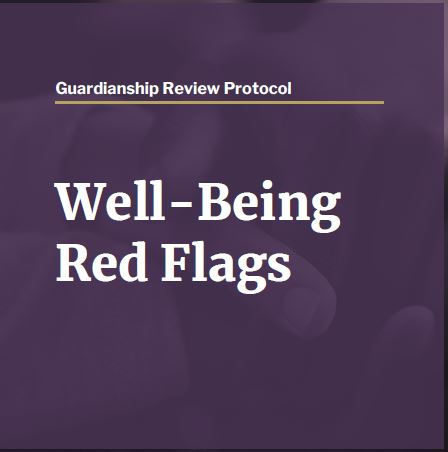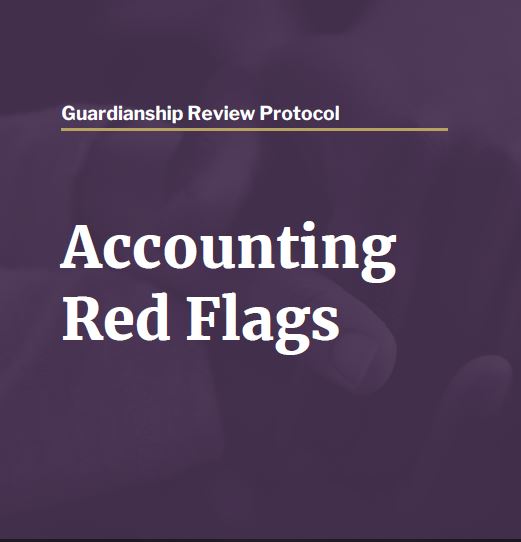The court’s duty to protect the well-being of an individual does not end when it appoints a guardian or conservator. After appointment, the court has an ongoing duty to monitor the guardianship or conservatorship, holding the guardian accountable for ensuring the person’s needs are being met.
With a monitoring protocol, the court can:
- Identify guardians who are struggling,
- Guide a guardian who needs assistance in fulfilling their duties, and
- Stop a guardian from using their court appointed authority to abuse, neglect, or exploit an individual.
According to National Probate Court Standard 3.3.17, in monitoring the well-being of the respondent and the status of the estate on an on-going basis, the court should:
- Ensure that plans, reports, inventories, and accountings are filed on time,
- Review promptly the contents of all plans, reports, inventories, and accountings,
- Independently investigate the well-being of the respondent and the status of the estate, as needed, and
- Assure the well-being of the respondent and the proper management of the estate by improving the performance of the guardian and enforcing the terms of the court order.
Because resources are limited, courts must establish monitoring programs that are effective and sustainable. This involves the following steps:
- Use a case status of “Set for Review” or equivalent to be able to easily identify those cases.
- Send reminders to guardians of reports due.
- Produce and review “exception reports” to identify and act on cases that are missing required reports.
- Improve data collection as outlined in the Guardianship/Conservatorship Monitoring – Recommended Data Elements.
- Identify cases that may require a higher level of monitoring (see "Concerns that warrant a higher level of monitoring" below).
- Provide clear instructions about reporting
- Provide guardians or conservators with a list of the court's expectations written in plain English with translations as appropriate.
- Provide training for guardians
- Make it easy for guardians to report
Examples:
- Provide printed and/or online training materials on the duties of a guardian.
- Provide in-person training by court staff or professional guardians.
Examples:
- NCSC: Finding the Right Fit: Decision-Making Supports and Guardianship
- Alaska: Education for Guardians and Conservators
- Arizona: Probate Training – Non-Licensed Fiduciaries
- Maryland: Guardian Orientation Program
- Nebraska: Guardian and Conservator Education
For more information, see the section "Guardianship/Conservatorship Qualifications & Training."
- Provide training for court staff on their role in monitoring
- NCSC Guardianship Review Well-Being Protocol
- NCSC Guardianship Review Accounting Protocol
The Respondent:
- Has no relatives or active friendships
The Estate:
- Is large and complicated with significant amounts of cash and securities
The Guardian/Conservator:
- Talks about being exhausted and overwhelmed
- Wants to resign
- Keeps changing attorneys or attorneys try to withdraw
- Has little knowledge about caring for dependent adults or has little experience with financial matters
- Excessively controls all access to the respondent and insists on being the sole provider of information to friends and family
- Does not permit the respondent to be interviewed alone
- Changes the respondent's providers to his/her own personal providers (e.g., physicians, dentist, accountants, bankers)
- Has financial problems (for example, tax issues, bankruptcy, is financially dependent on the person under guardianship)
- Has a mental health issue, substance abuse disorder, or poor coping skills
- Has personal problems (e.g., illness, divorce, a family member with a disabling accident or illness)
The Family:
- Has a history of conflict
- Disagrees about the care for the person or of the estate
- Is financially dependent on the person under guardianship
There may be situations in which a loved one or other interested person questions whether the person under guardianship is receiving necessary care. The National Probate Court Standards (Standard 3.3.18) directs courts to establish a process for these individuals to notify the courts of their concerns and for courts to review these complaints and determine whether the guardianship should be modified or terminated.
The Standards instruct courts to ensure that the process is developed with the user in mind - as litigants seeking this assistance are typically unrepresented - and allows for emergency/urgent situations.
The Standards offer the following considerations when developing a complain/grievance process:
Submission of the complaint/grievance:
- A written submission may help reduce frivolous requests that can take up a great deal of time and resources.
- Courts can simplify this process by assigning a specific staff member to receive and process the forms, establish a designated email address for submission, and a standardized form available online.
Reviewing the complaint/grievance:
- Upon review of the complaint/grievance, courts can take a variety of actions including but not limited to:
- Referrals to services
- Investigation by a court visitor
- Ordering the guardian to address the concerns raised in the complaint/grievance
- Mediation
- Setting a hearing
- This Judicial Response Protocol can help courts identify strategies for addressing these concerns.
Resources:
- Alaska: Public Guardian Grievance Process
- Idaho: Process for Filing a Complaint on a Guardianship/Conservatorship
- New Mexico: Grievance Process and Forms (available in English and Spanish)
- Summit County, Ohio: Guardianship Complaint Form
- Texas: Complaint Form
- Washington: Process for Modifying, Terminating, or Complaining About a Guardianship
- Wayne County, Michigan: Complaint Form
- Wisconsin: Process for Guardianship Complaints
Red Flags
These printable lists of red flags are intended to help the reviewer identify potential problems in a guardianship or conservatorship. However, they are not exhaustive.
The "red flags" associated with financial and accounting matters can be more readily identified than those associated with well-being issues. While accountings can be scrutinized by a cadre of volunteers or staff with some financial background, health care issues and the potential for abuse and neglect require home visits and more intensive monitoring efforts. Monitoring resources in most courts remain insufficient to identify and craft appropriate responses to "red flags." To support courts with monitoring these cases, NCSC has developed protocols for monitoring guardianships and conservatorships.
When such "red flags" are present, the National Probate Court Standards suggest that these cases may benefit from additional services or training, an examination into the case through a visitor, guardian ad litem, adult protective services, or a hearing.
Resources
- NCSC Conservatorship Accountability Project
- National Probate Court Standards
- Guarding the Guardians: Promising Practices for Court Monitoring
- NCSC Guardianship Review Well-Being Protocol
- NCSC Guardianship Review Accounting Protocol
- "What's Working in Guardianship Monitoring: Challenges and Best Practices" (Hurme and Robinson, 2022)
More information on the routines and best practices for standard monitoring of all Guardianships and Conservatorships can be found in the sections linked below.



